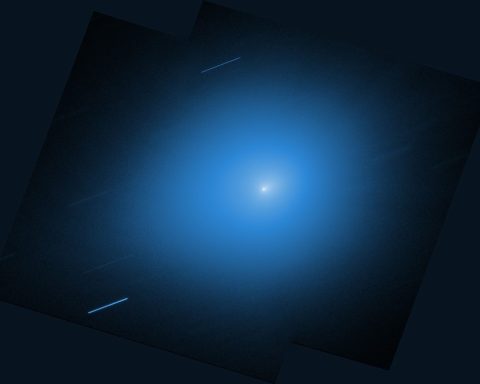- Planets & Moon: A slim crescent Moon will drift near Sagittarius’s “Teapot” on Sept 28–29. Saturn (recently at opposition) rises in the east after sunset and stays up most of the night, while Mars sets low in the west [1]. In the pre-dawn sky Venus lies low in the east and Jupiter shines higher above it [2]. (Mercury, about mag –1.0, and Mars will also appear as bright “stars” near the Moon late this week [3].) The Moon reaches first quarter on the 29th (23:54 UTC) [4].
- Meteor Activity: Skies are fairly quiet. Only minor showers are active: the Southern Taurids (debris from comet Encke) produce about 3 meteors per hour around local midnight (radiant in Pisces), and the Orionids are producing much less than 1 per hour now (their peak is Oct 23) [5] [6]. Sporadic meteors will dominate: AMS forecasts ~10 meteors/hour just before dawn (mid-Northern latitudes) and ~2/hour in the evening [7]. No major fireball event is expected, though any bright bolides should still be reported (see the American Meteor Society).
- Aurora & Space Weather: Conditions are expected to be very quiet. NOAA’s 3-day forecast shows the planetary Kp index staying at ~2–4 (below storm threshold) on Sept 28–30; “No G1 (minor) or greater geomagnetic storms are expected” [8]. In other words, auroras will be confined to very high latitudes unless an unexpected blast occurs. (Spaceweather.com gives only a small chance of a glancing disturbance; mid-latitude odds of any active aurora are ≲30% [9] [10].) Similarly, only a modest chance of M-class solar flares is forecast (≈55% chance per day of minor R1–R2 radio blackouts [11]), and no radiation storm is predicted [12]. In short, Northern/Southern Lights hunters should not expect a big show on these dates.
- Satellites & ISS: Watch for satellites! SpaceX plans a Starlink launch on Sept 28 at 23:32 GMT (7:32 p.m. EDT) delivering 24 new broadband satellites [13]. In the nights immediately after launch, observers may see the classic Starlink “train” – a line of dozen‑plus points crossing the sky. As Space.com explains, “the Starlink satellite train is best seen in the days immediately following a launch… they often appear as a bright, fast-moving line of lights” [14]. These satellites will be most visible shortly after sunset or before sunrise, when sunlight still illuminates them. Also, the ISS will make visible passes around twilight. NASA notes: “All International Space Station sightings will occur within a few hours before or after sunrise or sunset… as the Sun reflects off the space station and contrasts against the darker sky.” [15] (Check NASA’s Spot the Station for precise pass times from your location.)
- Other Phenomena: No eclipse occurs on Sept 28–29 (the last event was a partial solar eclipse on Sept 21 [16]). A new comet, C/2025 R2 (SWAN), is becoming visible: astronomers call it a “true once-in-a-lifetime visitor” with a long tail [17]. It’s faint but may be spotted with binoculars low in the western sky after sunset. Finally, observers under very dark skies might see the zodiacal light (a faint triangular glow along the ecliptic) before dawn – EarthSky notes it can appear in late September in the weeks around the equinox [18].
Meteor Showers and Fireballs
This weekend’s meteor activity will be modest. No major shower peaks on Sept 28–29. The Orionids (parent comet Halley) have just started but are weak – current rates are well under 1 meteor/hour and won’t peak until Oct. 23 [19]. The only notable shower is the Southern Taurids (from comet 2P/Encke), active Sept 23–Nov 12 with a broad radiant. AMS predicts a Southern Taurid rate of about 3/hour around local midnight (the radiant in Pisces, best near 1 a.m.) [20]. All other named showers (epsilon Geminids, sextantids, etc.) are producing <1/hr [21] [22]. Thus most meteors will be sporadic – random space dust. AMS estimates roughly 10 sporadic meteors per hour just before dawn in the mid-northern latitudes (about 2/hour in evening twilight) [23]. Importantly, a bright first-quarter Moon on Sep 29 will drown out many faint meteors in the late-evening sky (though the crescent Moon on Sep 28 is fairly slim). Observers should use dark sky sites and allow eyes to adjust. As AMS meteor expert Robert Lunsford notes, actual visual rates depend on factors like moonlight and light pollution.
Auroras and Space Weather Forecast
NOAA/SWPC predicts only quiet to unsettled geomagnetic conditions. In the official 3-day outlook issued Sep 28, the highest expected planetary Kp index is 4.00, which is still below the G1 storm threshold [24]. The forecast explicitly states “No G1 (Minor) or greater geomagnetic storms are expected” on Sept 28–30 [25]. In practice, this means any auroras would be confined to very high geomagnetic latitudes. Space.com’s space weather forecasts concur that mid-latitude aurora chance is low. (Spaceweather.com gave roughly a 30% chance of active conditions at mid-latitudes 0–24 hours ahead – and just a 1% chance of severe storms – with higher latitudes having somewhat more risk [26].)
Solar activity is also muted. The 3-day outlook shows only a 1% chance of any S1-level radiation storm and a 55% daily chance of R1–R2 (minor-moderate) radio blackouts [27] [28]. In short, NOAA’s analysts expect no major solar flares or CMEs on these dates. So space weather experts say radio communications and GPS users will see mostly normal conditions. As NOAA’s Space Weather Prediction Center puts it, in this interval there are no significant active regions or solar wind streams forecast that would drive geomagnetic storms [29] [30].
“All International Space Station sightings will occur within a few hours before or after sunrise or sunset… as the Sun reflects off the space station and contrasts against the darker sky.” [31]
Moon, Planets, and Alignments
Late September brings a beautiful celestial pairing. On Sept 28 the thin waxing crescent Moon will lie near the “Teapot” asterism of Sagittarius in the southern sky [32]. By Sept 29 the Moon reaches first quarter (23:54 UTC) [33], rising around local noon and appearing high by sunset. A handy guide from EarthSky notes: “On the evening of September 28, the fat waxing crescent moon will float near… the Teapot of Sagittarius” [34]. The Moon’s glare will make spotting faint deep-sky objects hard, but it adds drama to the Milky Way center.
Planet-wise, “two visible planets in the evening sky” catch the eye [35]. Mars (mag ~1.5) will be low in the southwest at dusk, quickly fading from view as the sky darkens. Saturn (mag 0.6) has just reached opposition on Sept 21 and rises in the southeast at dusk – it will shine upward all night [36]. As EarthSky explains, “Saturn is rising in the east as darkness falls… Saturn reached opposition on September 21 and is still visible nearly all night” [37]. On the morning side, three planets are prominent [38]: Venus (very bright, mag –3.9) will be low in the east, with Jupiter (mag –2.0) higher above it. EarthSky notes “Venus will lie low in the east, and Jupiter will shine higher in the morning sky” [39] as they slowly drift apart after their recent conjunction. (Saturn is also still up in the pre-dawn southeast.)
Observers should also keep an eye on Mercury. In late September it is an evening object low above the western horizon shortly after sunset. According to sky guides, Mercury (mag ≈–1) and Mars will be the brightest dots near the Moon during Sept 22–28 [40]. That means on Sept 28 after sunset you might catch Mercury very low near the southwest horizon not far from the Moon. Binoculars can help pick it out against twilight.
Satellites and ISS Passes
Starlink satellites: SpaceX’s broadband constellation is expanding rapidly. The 308th Starlink launch (mission Starlink 11-20) is scheduled for Sept 28 at 23:32 GMT [41]. The 24 newly deployed satellites will initially fly in a tight train. Enthusiasts should watch the nights following launch for a fanning chain of lights across the sky. As Space.com advises, “The Starlink satellite train is best seen in the days immediately following a launch… they often appear as a bright, fast-moving line of lights crossing the sky” [42]. These trains are visible only when sunlight still illuminates the satellites (shortly after sunset or before sunrise) while the ground is dark. Use a tracking app or website (like FindStarlink) for precise predictions from your location.
ISS (International Space Station): The station will make several dawn/dusk flyovers visible as a bright “star” moving steadily across the sky. NASA explains that all ISS sighting opportunities occur within a few hours of sunrise or sunset [43]. For example, on Sept 29–30 observers in Europe or North America might catch an early-morning pass. (Exact times vary by location.) The ISS will look like a non-blinking point of light moving faster than any airplane. Check NASA’s SpotTheStation website/app for timetables of upcoming ISS passes over your city.
Comets and Other Skyglow
Comet C/2025 R2 (SWAN): A new visitor may be lurking low in the western sky after sunset. Discovered in 2025, Comet SWAN is a long-period comet with a beautiful tail. EarthSky reports that astronomers say “Comet C/2025 R2 (SWAN)…might brighten enough to be seen without binoculars, but it’s tough to spot in the western sky after sunset” [44]. If you have a clear western horizon, try scanning with binoculars in late September; look roughly halfway between Mars and the star Zubenelgenubi (α Libra) after dusk. It will remain a binocular/telescope target (rather than naked-eye) through early October.
Zodiacal Light: Around the autumn equinox, observers under dark skies sometimes see a faint, cone-shaped glow called the zodiacal light extending up from the western horizon after sunset (in the Northern Hemisphere) or before dawn (in the Southern Hemisphere). EarthSky notes that “the zodiacal light may be visible before morning twilight for Northern Hemisphere observers in dark skies around the September equinox” [45]. If you’re in a very dark location with a clear horizon, look for this pale glow – it is sunlight scattered by interplanetary dust and can be a beautiful sight on moonless nights.
Eclipses: There are no lunar or solar eclipses on Sept 28–29. The previous eclipse was a partial solar eclipse on Sept 21 (visible only from high southern latitudes [46]), and the next will be a partial solar eclipse on Feb 17, 2026. This weekend’s Moon is not causing any occultations of bright stars or planets, just its nightly journey through the constellations.
Expert Tip: Skywatchers are advised to stay updated with official forecasts. For aurora predictions, check NOAA SWPC’s Aurora Dashboard or apps like SpaceWeatherLive. For ISS passes, use NASA’s Spot the Station. And for meteor watching, find a dark site away from city lights after moonset (around 3–4 a.m. local) to maximize your odds of seeing sporadic meteors.
Sources: Official forecasts and reports from NOAA/SWPC, the American Meteor Society, SpaceWeather.com, NASA, and astronomy news (EarthSky, Space.com, etc.) were used to compile this guide [47] [48] [49] [50] [51] [52]. (Astronomical event timings and visibility may vary by location and local conditions.)
References
1. earthsky.org, 2. earthsky.org, 3. starwalk.space, 4. earthsky.org, 5. www.amsmeteors.org, 6. www.amsmeteors.org, 7. www.amsmeteors.org, 8. services.swpc.noaa.gov, 9. www.spaceweather.com, 10. services.swpc.noaa.gov, 11. services.swpc.noaa.gov, 12. services.swpc.noaa.gov, 13. starwalk.space, 14. www.space.com, 15. www.nasa.gov, 16. www.timeanddate.com, 17. earthsky.org, 18. earthsky.org, 19. www.amsmeteors.org, 20. www.amsmeteors.org, 21. www.amsmeteors.org, 22. www.amsmeteors.org, 23. www.amsmeteors.org, 24. services.swpc.noaa.gov, 25. services.swpc.noaa.gov, 26. www.spaceweather.com, 27. services.swpc.noaa.gov, 28. services.swpc.noaa.gov, 29. services.swpc.noaa.gov, 30. services.swpc.noaa.gov, 31. www.nasa.gov, 32. earthsky.org, 33. earthsky.org, 34. earthsky.org, 35. earthsky.org, 36. earthsky.org, 37. earthsky.org, 38. earthsky.org, 39. earthsky.org, 40. starwalk.space, 41. starwalk.space, 42. www.space.com, 43. www.nasa.gov, 44. earthsky.org, 45. earthsky.org, 46. www.timeanddate.com, 47. services.swpc.noaa.gov, 48. www.amsmeteors.org, 49. earthsky.org, 50. starwalk.space, 51. www.space.com, 52. www.nasa.gov










